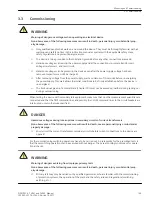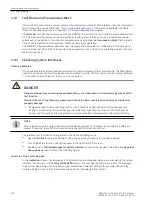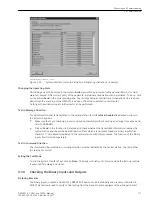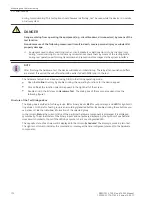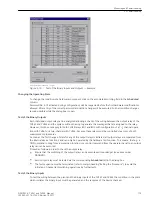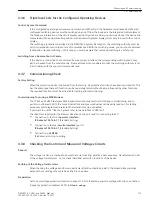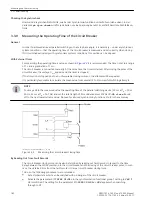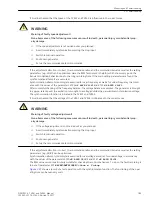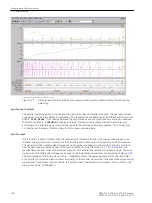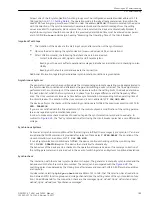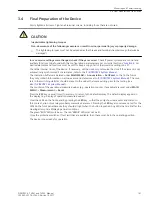
terized phase sequence voltage, the corresponding annunciations are indicated. Thus, the secondary wiring
mode to the device is checked.
The final testing of the secondary voltage circuits takes place by the fact that the both voltage transformers
receive the identical voltage. In addition, the generator feeder has to be separated from the busbar. The circuit
breaker (b) is closed, so that both voltages U1 and U2 are identical.
By reading the operational measured values one should check that within the framework of the measuring
tolerances
•
Both voltages U1 and U2 are equal
•
Both frequencies f1 and f2 are equal.
If the secondary voltages are not equal due to different voltage transformer, an appropriate correction can be
performed with the help of the adaptation factor 6121
Balancing U1/U2
. The same applies for the phase
angle deviation tolerance, which can be adapted with the help of the parameter 6122
ANGLE ADJUSTM.
.
In the operational measured values of the 7VE61 and 7VE63 one should check also that within the framework
of the measuring tolerances
•
The difference voltage dU is zero
•
The difference frequency df is zero
•
The difference angle dα is zero.
i
i
NOTE
If for three-phase systems from the 7VE61 and 7VE63 the phase rotation checks are executed, the same
phase rotation has to be displayed for both voltages in the operational measured values.
In case of several synchronizing points, each of the synchronizing points has to be tested.
Checking with Busbar Voltage Transformer
With busbar voltage transformers, it may be necessary to check for each busbar the applied voltage via the
isolator auxiliary contacts by reading the operational measured values and comparing them with the actual
voltage. Each of the busbar voltages on the measurement location has to be switched one by one by switching
the isolators or the temporary bridging of the isolator auxiliary contacts.
The voltage checks for the system voltage as well as for generator voltage in the measuring field can be
performed with an arrangement as shown in
. Only one of the circuit breakers (a) or (b) may be
closed! With the opened generator switch (b) and the closed section switch (a) the system voltage is applied
in the measuring field. After opening of the section switch (a) and closing the generator switch (b) the voltage
of the generator voltage can be checked.
First execute the voltage check with the network voltage (b) open, (a) closed. In the 7VE61 and 7VE63 the
voltage U1 is read out and compared with the actual voltage.
Now, the phase rotation is checked. if for three-phase systems two phase-to-phase voltages are connected to
the device and the parameter 6113
PHASE SEQUENCE
is set to clockwise rotation (
L1 L2 L3
) or set to anti-
clockwise rotation (
L1 L3 L2
) the phase sequence voltage can be read out in the operational measured
values. Thus, the secondary wiring mode to the device is checked.
Finally open the section switch opens again (a).
After starting up the generator, the phase rotation check is executed with the generator voltage, (a) open, (b)
closed. The voltage U2 in the 7VE61 and 7VE63 can be read out in the operational measured values and
compared with the actual voltage. It has to be taken into consideration that the operational measured value of
the voltage U2 is influenced by the adaptation factor 6121
Balancing U1/U2
.
The phase rotation of the generator voltage must be equal to the phase rotation of the system voltage. If two
phase-to-phase voltages are connected to the device and the parameter 6113
PHASE SEQUENCE
is set to
clockwise rotation (
L1 L2 L3
) or set to anti-clockwise rotation (
L1 L3 L2
) the phase sequence voltage can
be read out in the operational measured values. Thus, the secondary wiring mode to the device is checked.
The final testing of the secondary voltage circuits takes place by the fact that the both voltage transformers
receive the identical voltage. In addition, the section switch (a) is open, no network voltage is available. The
generator circuit breaker (b) is closed, so that both voltages U1 and U2 are identical.
Mounting and Commissioning
3.3 Commissioning
178
SIPROTEC 4, 7VE61 and 7VE63, Manual
C53000-G1176-C163-3, Edition 10.2017
Summary of Contents for SIPROTEC 4 7VE61
Page 8: ...8 SIPROTEC 4 7VE61 and 7VE63 Manual C53000 G1176 C163 3 Edition 10 2017 ...
Page 24: ...24 SIPROTEC 4 7VE61 and 7VE63 Manual C53000 G1176 C163 3 Edition 10 2017 ...
Page 142: ...142 SIPROTEC 4 7VE61 and 7VE63 Manual C53000 G1176 C163 3 Edition 10 2017 ...
Page 192: ...192 SIPROTEC 4 7VE61 and 7VE63 Manual C53000 G1176 C163 3 Edition 10 2017 ...
Page 222: ...222 SIPROTEC 4 7VE61 and 7VE63 Manual C53000 G1176 C163 3 Edition 10 2017 ...
Page 230: ...230 SIPROTEC 4 7VE61 and 7VE63 Manual C53000 G1176 C163 3 Edition 10 2017 ...
Page 256: ...256 SIPROTEC 4 7VE61 and 7VE63 Manual C53000 G1176 C163 3 Edition 10 2017 ...
Page 314: ...314 SIPROTEC 4 7VE61 and 7VE63 Manual C53000 G1176 C163 3 Edition 10 2017 ...
Page 316: ...316 SIPROTEC 4 7VE61 and 7VE63 Manual C53000 G1176 C163 3 Edition 10 2017 ...
Page 330: ...330 SIPROTEC 4 7VE61 and 7VE63 Manual C53000 G1176 C163 3 Edition 10 2017 ...






